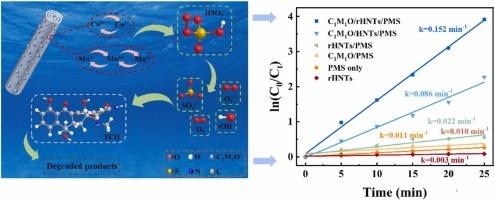Halloysite Nanotubes-based Co-Mn Composite Oxides for Efficient Degradation of Tetracycline Hydrochloride via Peroxymonosulfate Activation
IF 6.3
2区 材料科学
Q2 CHEMISTRY, PHYSICAL
引用次数: 0
Abstract
A facile deposition-precipitation method was adopted to fabricate a series of Co-Mn bimetallic composite oxides supported on reconstructed halloysite nanotubes (CMO/rHNTs), which were used for the efficient degradation of tetracycline hydrochloride (TCH) through peroxymonosulfate (PMS) activation. The metal loading capacity of rHNTs was found to be 1.8-fold higher than that of pristine HNTs. Benefitting from enhanced PMS activation facilitated by accelerated electron transfer between Co2+/Co3+ and Mn2+/Mn3+/Mn4+ redox couples, the C1M1O/rHNTs catalyst (with a Co/Mn molar ratio of 1: 1 and theoretical metal loads of 10 wt%) afforded the highest TCH degradation efficiency of 98% (rate constant k=0.152 min-1) within 25 min at initial pH 4.47, 0.6 mg⸱mL-1 PMS and 0.2 mg⸱mL-1 catalyst. Mechanistic studies identified synergistic contributions from SO4•− and 1O2 pathways to TCH degradation. Based on the degradation intermediates detected by LC-MS, the major degradation pathways of TCH mediated by C1M1O/rHNTs were proposed. Moreover, the C1M1O/rHNTs nanocomposites exhibited excellent reusability, maintaining >90% TCH removal efficiency after five consecutive cycles. Of note, the catalyst demonstrated exceptional adaptability across a broad pH range (4.47-10.51) and strong resistance toward common interfering anions (NO3− Cl−, SO42−, H2PO4−).

高岭土纳米管基Co-Mn复合氧化物在过氧单硫酸盐活化下高效降解盐酸四环素
采用快速沉积-沉淀法制备了一系列负载在重构高岭土纳米管上的Co-Mn双金属复合氧化物(CMO/rHNTs),并利用过氧单硫酸盐(PMS)活化法高效降解盐酸四环素(TCH)。发现rhnt的金属承载能力比原始hnt高1.8倍。由于Co2+/Co3+和Mn2+/Mn3+/Mn4+氧化还原对之间的加速电子转移促进了PMS活化,c1m10 /rHNTs催化剂(Co/Mn摩尔比为1:1,理论金属负荷为10 wt%)在初始pH为4.47、0.6 mg⸱mL-1 PMS和0.2 mg⸱mL-1催化剂的条件下,在25分钟内达到98%的最高TCH降解效率(速率常数k=0.152 min-1)。机制研究确定了SO4•−和1O2途径对TCH降解的协同作用。基于LC-MS检测到的降解中间体,提出了c1m10 /rHNTs介导TCH降解的主要途径。此外,c1m10 /rHNTs纳米复合材料具有良好的可重复使用性,在连续5个循环后仍保持90%的TCH去除率。值得注意的是,该催化剂在较宽的pH范围内(4.47-10.51)表现出优异的适应性,并对常见的干扰阴离子(NO3−Cl−,SO42−,H2PO4−)具有很强的抗性。
本文章由计算机程序翻译,如有差异,请以英文原文为准。
求助全文
约1分钟内获得全文
求助全文
来源期刊

Journal of Alloys and Compounds
工程技术-材料科学:综合
CiteScore
11.10
自引率
14.50%
发文量
5146
审稿时长
67 days
期刊介绍:
The Journal of Alloys and Compounds is intended to serve as an international medium for the publication of work on solid materials comprising compounds as well as alloys. Its great strength lies in the diversity of discipline which it encompasses, drawing together results from materials science, solid-state chemistry and physics.
 求助内容:
求助内容: 应助结果提醒方式:
应助结果提醒方式:


